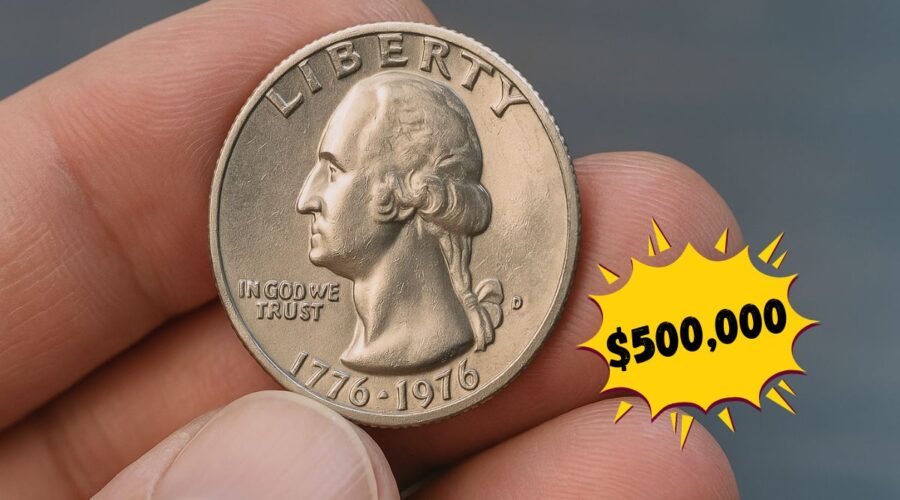The 1976 Bicentennial Quarter- How This Rare Coin Became Worth $500,000 and Made History
The 1976 Bicentennial Quarter holds a special place in American numismatics. While most of these quarters are common, certain rare variants have fetched astonishing prices, with some selling for up to $500,000.
This article delves into the history, unique features, and factors that contribute to the immense value of these rare coins.
Historical Background
In 1976, to commemorate the 200th anniversary of the United States’ independence, the U.S. Mint released special editions of the quarter, half dollar, and dollar coins. These coins featured the dual date 1776–1976 and unique reverse designs.
- Design Selection: A national competition was held to select the designs. For the quarter, Jack L. Ahr‘s depiction of a colonial drummer was chosen. This design, often referred to as the “Drummer Boy”, symbolizes the spirit of the American Revolution.
- Mintage: The Bicentennial quarters were minted in large quantities to ensure widespread circulation. However, specific variants and errors are exceedingly rare and valuable.
Unique Features of the 1976 Bicentennial Quarter
1. Dual Date (1776–1976)
Unlike regular quarters, the Bicentennial quarter features a dual date to mark the 200th anniversary of American independence.
2. Reverse Design
The reverse showcases a colonial drummer with a victory torch encircled by thirteen stars, representing the original colonies.
3. Mint Marks and Composition
The quarters were minted at three locations:
- Philadelphia (No Mint Mark): Standard clad composition.
- Denver (D): Standard clad composition.
- San Francisco (S): Produced both in clad and 40% silver compositions, primarily for collectors.
Factors Contributing to High Value
1. Mint Errors
Certain Bicentennial quarters possess minting errors that significantly increase their value:
- Double Die Obverse (DDO): This error results in a noticeable doubling of design elements on the obverse side.
- Off-Center Strikes: Coins struck off-center can be highly sought after, especially if the date is still visible.
- Struck on Wrong Planchet: Some quarters were mistakenly struck on planchets meant for other denominations, making them extremely rare.
2. High-Grade Specimens
Coins graded MS-67 or higher by professional grading services are rare and command premium prices.
3. Limited Silver Proofs
The San Francisco Mint produced a limited number of 40% silver proof Bicentennial quarters. These coins, especially in pristine condition, are highly valuable.
Notable Sales and Auction Records
Below is a table highlighting some of the most notable Bicentennial quarter sales:
| Variant | Grade | Sale Price | Notable Features |
|---|---|---|---|
| 1976-S Silver Proof Quarter | PR 70 DCAM | $19,200 | Deep cameo contrast, perfect condition |
| 1976-D Double Die Obverse | MS 66 | $8,400 | Prominent doubling on obverse |
| 1976-S Silver Proof Deep Cameo | PR 70 DCAM | $2,760 | Exceptional mirror-like finish |
| 1976-S Clad Proof Deep Cameo | PR 70 DCAM | $920 | High-quality clad proof with deep cameo effect |
| 1976-S Silver Proof Cameo | PR 66 CAM | $128 | Strong cameo contrast in silver proof |
Identifying Valuable Bicentennial Quarters
To determine if your Bicentennial quarter is valuable, consider the following:
- Check for Mint Marks: Look for an “S” mint mark indicating a San Francisco mint, which may denote a silver proof coin.
- Examine for Errors: Use a magnifying glass to inspect for doubling, off-center strikes, or other anomalies.
- Assess the Condition: Coins with minimal wear and sharp details are more likely to be valuable.
- Weigh the Coin: Silver quarters weigh more than their clad counterparts.
The 1976 Bicentennial Quarter is more than just a piece of currency; it’s a symbol of American heritage. While most are common, rare variants with unique features have captivated collectors and fetched impressive sums at auctions. If you possess a Bicentennial quarter, it’s worth examining closely—you might just have a hidden treasure in your hands.
FAQs
How can I tell if my 1976 quarter is silver?
Silver Bicentennial quarters have an “S” mint mark and weigh more than clad versions. Additionally, the edge of a silver coin lacks the copper stripe seen in clad coins.
Are all Bicentennial quarters valuable?
While most are common and worth face value, those with mint errors, high grades, or silver composition can be worth significantly more.
Where can I get my Bicentennial quarter appraised?
Reputable coin dealers, numismatic associations, or professional grading services like PCGS or NGC can provide appraisals.


Leave a Reply